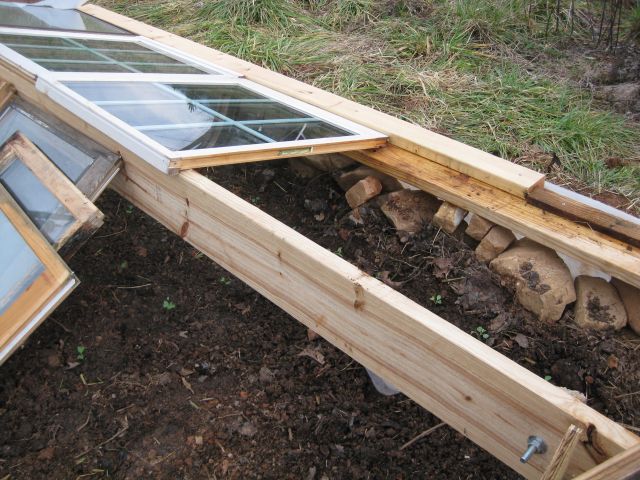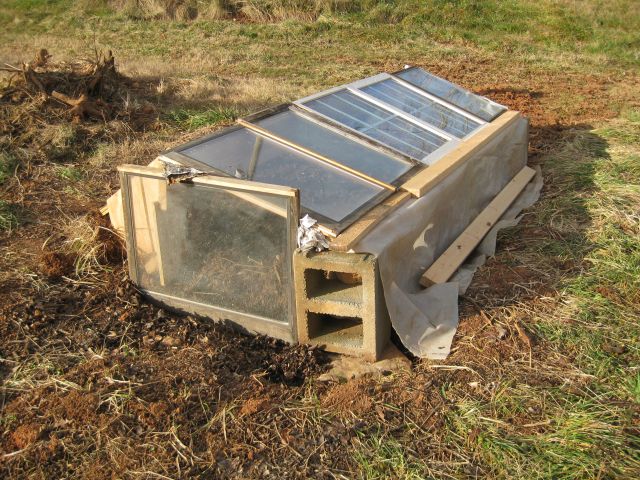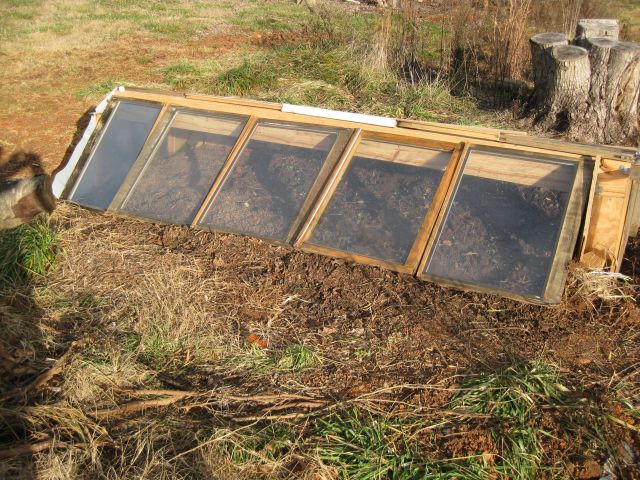In a previous post I mentioned building my first cold frame using bargain priced windows from the local thrift, cement blocks and lumber. The seedlings in this cold frame are growing well and when it is cold (say 18 F outside temperature) the temperature in the cold frame is approximately 10 F higher. During the day the differential increases. And it keeps out the frost. So I am hoping to grow decent sized vegetables.
One cold frame was not enough because I had 10 windows remaining and there is a better site for a cold frame – on top of the hill where it catches early morning sun to late afternoon son. This location is unfenced and close to a road so there is a possibility of unwelcome attention, therefore my decision to locate the first cold frame in the better protected vegetable growing area. Nonetheless, the cost of building a cold frame is modest and the full time attention of the sun is a major plus.
Construction was very similar to the first frame except I dispensed with all but two cement blocks (instead of the 17 used in the first cold frame). The blocks are located at each end of the cold frame and are spanned by a 10ft by 8″ wide 2″ thick, plank. In between the two cement block supports I built a stone wall of sorts using the large stones I had uncovered when I dug a contour ditch. I used a hammer and stone chisel to cut faces on the stones so they would stack.

The purpose of the stones is to absorb the sun’s heat during the day and release it during the night. Only the top layer of the stones is visible – there are two (more skilfully arranged) layers below the soil level. To prevent the warm air exiting through the stones I draped 6 mil plastic sheeting on the outside of the frame.

As before, I used the windows from the thrift store to enclose the frame. The savings from using 15 fewer cement blocks was partially offset by the cost of 3 additional window frames I had to purchase from the thrift store – a different floor manager did the pricing and he wanted $4 per window rather than $1 – such are the vagaries of life.

The gaps and openings I covered with bits of plank or plastic. I have now introduced some collard and broccoli seedlings and in the next week will add the remaining spinach and other cool season vegetables – and wait and hope that I will get a worthwhile yield.

You know, I’ve always thought that if you didn’t have a coldframe or maybe a hotframe, somehow you weren’t a serious gardener. Just one of those silly thoughts that we have. And so, I’ve never gone beyond collecting drawings. But your pics have changed that. They have an appealing feel of funkiness. I know where I can scrounge some old windows and I know where I’d locate the coldframe.
close to a road so there is a possibility of unwelcome attention
A good planting of osage orange would discourage those who stray off the beaten path – it was the barbedwire of choice before barbedwire was invented. Additionally, it’s a native species, coppiceable, and has a high BTU. I started some from seed this year and was very impressed with the germination rate (+90%) and the growth rate.
Regards,
Mike